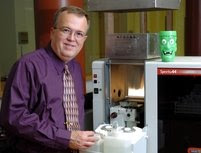Jessica Cox, of Tucson, Ariz., was born without arms, but that has only stopped her from doing one thing: using the word "can't."
Her latest flight into the seemingly impossible is becoming the first pilot licensed to fly using only her feet.
Click here for photos of Jessica.
With one foot manning the controls and the other delicately guiding the steering column, Cox, 25, soared to achieve a Sport Pilot certificate. Her certificate qualifies her to fly a light-sport aircraft to altitudes of 10,000 feet.
"She's a good pilot. She's rock solid," said Parrish Traweek, 42, the flying instructor at San Manuel's Ray Blair Airport.
He runs PC Aircraft Maintenance and Flight Services and has trained many pilots, some of whom didn't come close to Cox's abilities.
"When she came up here driving a car," Traweek recalled, "I knew she'd have no problem flying a plane."
Finding a plane that was compatible with her abilities was a task within itself. She found it in the Ercoupe, a plane manufactured in the mid-1940s. Locating one took her to Florida and California, although she finally find one less than 70 miles away in San Manuel.
Flight lessons usually run more than $100 per hour, but Cox was able to get her 40-plus hours of training through an Able Flight Scholarship.
"Once you're with Jessica for about 20 minutes, you don't even notice she doesn't have arms," Traweek said from the one of the airport's hangars.
Cox, unwrapping a piece of chewing gum with her toes nearby, was clad in a yellow T-shirt sporting a stick figure with truncated arms beneath the phrase: "Look Ma, No Hands."
"Jessica's showing people there are no limits," he said. "Jessica's incredible. She really is."
Most who meet her, especially on her motivational speaking circuit, agree. She's spoken at hundreds of gigs, from Wisconsin to Phoenix, where she shares her upbeat philosophy and incredible story.
Doctors never learned why she was born without arms, but she figured out early on that she didn't want to use prosthetic devices.
"Instead of investing so much time in being normal," she said, "I realized it was more important to celebrate my difference."
She gave up the prosthetic arms for good when she turned 14 and her family moved to Tucson from their hometown of Sierra Vista.
"They handicapped me," she said of the prosethetic arms, which she keeps shoved in the back of her closet.
"When we moved to Tucson, I had a fresh slate," she said.
That slate is now covered with achievements from a bachelor's degree in psychology from the University of Arizona to two black belts in tae kwon do. She's also seeking a publisher for her life story.
She keeps even more active with swimming and walking.
"It's critical to maintain strength and flexibility in my legs for any kind of activity," she said.
Her feet have become so agile, she said. that a recent X-ray showed her toe joints looked more like fingers.
"The toes were curled in more like a hand would be," she said. "I had to ask the doctor, 'Does everyone's feet look like that?' "
Cox credits much of her success to her supportive family: mom Inez, 58; dad William, 68; brother Jason, 28; and sister Jackie, 23.
She is grateful for her ability to motivate others, and not only when she's speaking on stage.
"I realized when I go to the grocery store to get a gallon of milk and wheel the cart up to the cashier, I really don't have to say anything," she said.
(from FoxNews.com)






